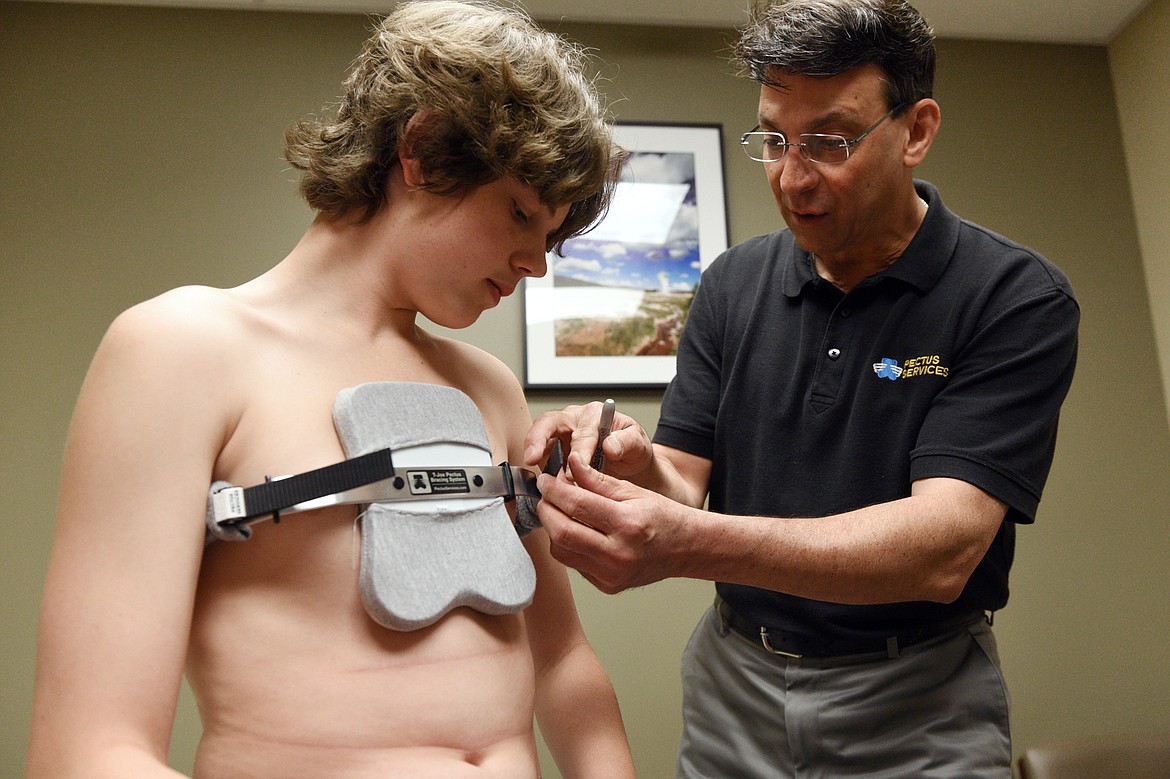Hospital offers non-surgical treatment for chest-wall deformity
A non-surgical device that corrects chest-wall deformities is now available at Kalispell Regional Healthcare, and 14-year-old Salem Steward was first in line to get the brace this week.
Kalispell Regional pediatric surgeons Drs. Gavin Falk and Federico Seifarth held the first chest-wall deformity clinic on Wednesday. They plan to offer similar clinics every six weeks for brace fittings. Previously, patients with the deformity had to travel to hospitals in Seattle, Salt Lake City or Denver for treatment, said Nurse Practitioner Rachel Fisherkeller, who was part of the inaugural clinic.
Joe Porcello of Pectus Services invented his flagship “T-Joe” bracing system in the mid-1990s and now sells the devices worldwide. He was on hand at the clinic to explain the non-surgical procedure to the medical staff and young patients being fitted with the brace.
Chest-wall deformities are common birth defects occurring in about one in every 300 to 500 children in the United States, according to information provided by Kalispell Regional Healthcare.
Pectus excavatum, or “funnel chest,” is caused by an inward growth of the breastbone and portions of the ribs. It’s three times more common in boys than in girls.
Pectus carinatum, or “pigeon chest,” causes the breast bone and rib cartilages to stick out.
Steward was getting a routine sports physical examination two years ago when Dr. Seifarth detected a protruding bump in his chest area that was diagnosed as a chest-wall deformity. The bump became more pronounced over time, making him an ideal candidate for the special brace.
Steward’s mother, Nicole Steward, said the doctor explained that if her son was fitted for a brace, it would help correct the problem.
“If we didn’t do the procedure now, the surgery later would be invasive,” she said.
The younger Steward, who plays basketball and is an avid skateboarder, listened intently as Porcello explained the brace and the procedure for wearing it.
“Over the next five days, don’t take it off, not even to shower,” Porcello cautioned. “Then for six weeks after that only take it off to shower.
“The first day it will feel really tight, but after 24 to 48 hours you’re home free,” Porcello assured Steward.
The T-Joe brace treatment spans 30 weeks, with checkups and 3-D scans scheduled to track each patient’s progress.
Falk learned about the T-Joe brace and met Porcello when he was completing his pediatric surgery fellowship at Nicklaus Children’s Hospital in the Miami Children’s Health System in Florida.
There are other companies that make similar non-surgical devices, but Porcello’s brace is simple and straight-forward, and costs only $700 to $800, while other braces can cost up to $3,000 to $4,000, Falk said.
The T-Joe has about an 85 percent success rate, he added. Before bracing became a good option for correcting chest-wall deformity, “it used to be a huge operation,” he said.
Surgical correction requires an incision in the mid-chest to remove abnormal ribs and reshape the sternum.
The average age range for correcting chest-wall deformities is about ages 12 to 15.
“I tell parent and children the main predictor of success is children using it” correctly for the full duration of treatment, Falk said about the brace.
Features Editor Lynnette Hintze may be reached at 758-4421 or lhintze@dailyinterlake.com.




